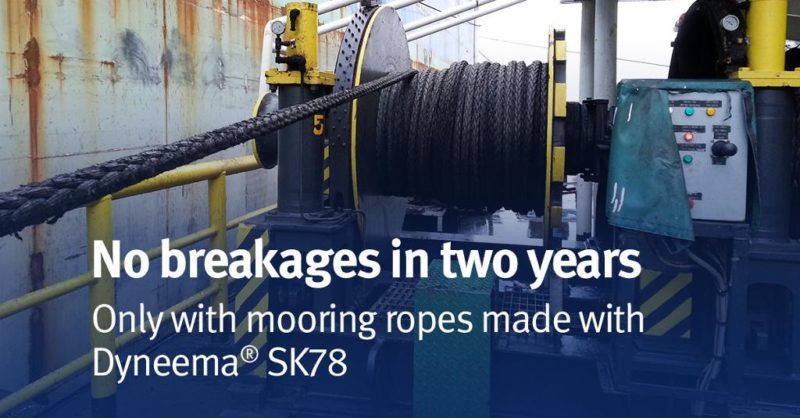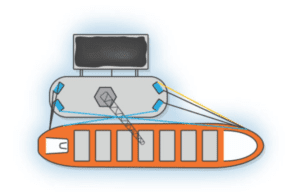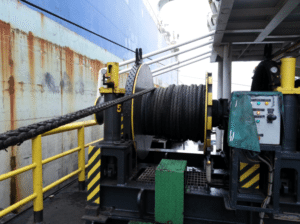How ROVs Are Transforming Offshore Oil & Gas
The oil and gas industry has always relied on innovation to explore further, drill deeper, and increase production. Today, one of the most transformative tools in offshore oil and gas...


In 2012, PT Indo Straits began researching the purchase of new spring line ropes for these vessels. The ropes were needed to position and stabilize transshipment crane barges. These barges are used out at sea to transship coal from smaller barges to large bulk carriers for onward transportation.
It didn’t take long for the company to determine what it wanted: ropes made with HMPE fiber. There were three reasons why: safety, easy handling, and to maximize operational efficiency. And obviously, the company wanted the best.
Our expected lifetime for the AmSteel®-Blue ropes was one year. We are looking forward to using them longer.
Coal transshipment configuration
 The image to the left represents a coal transshipment configuration with a PT Indo Straits crane barge.
The image to the left represents a coal transshipment configuration with a PT Indo Straits crane barge.
Lines in black and blue are ropes used as spring lines, which are most crucial for operations. The crew uses these two winches to give out or take in rope. These move the barge along the side of the bulker carrier and take most of the load. During transfer, the same ropes, supported by other polypropylene ropes, ensure the vessels remain in the same positon relative to each other.
Not all HMPE fiber is the same
In January 2013, PT Indo Straits purchased and installed the new 48mm diameter spring lines made with 12-strand generic HMPE fiber with a 32-strand polyester jacket. These ropes were specified with a breaking load of 165tons and expected to have a life expectancy of approximately 4,000 operational hours – roughly one year; which was a realistic reflection of the harsh conditions in which the ropes would be used: often heavy swells, coal dust and the many rough surfaces and sharp edges over which the ropes would have to run.
Unfortunately, these new ropes made with generic HMPE fiber broke within a week in operations. As the PT Indo Straits barge master involved puts it: “Once the jacket broke, the rope would not last. It broke quickly. This caused lots of additional work and exposed the crew and equipment to risk.”
Although there were no injuries to personnel or damage to equipment, PT Indo Straits takes a serious view in upholding safety and operational excellence for business success. They immediately contacted the DSM Dyneema Asia Pacific Technical Center in Singapore to investigate and seek recommendations even though these ropes that were purchased were not made of Dyneema® fiber. During investigations, PT Indo Straits learnt that not all HMPE fiber is the same in terms of performance, quality and consistency.
Demanding specifications
PT Indo Strait’s specifications were demanding so as to uphold its high standards in safety and operational effciency. The new replacement ropes should last longer than the rope made with generic HMPE fiber, and at least one year. There should be no or, at worst, minimal instances of ropes breaking, to reduce downtime and the number of crew required on deck.
Based on the initial investigations and their operational needs, PT Indo Straits decided to procure their ropes with Dyneema® from Samson, a worldwide leader in the development and manufacture of high-performance ropes.
Samson recommended its 48mm AmSteel®-Blue 12-strand rope made with Dyneema®, with a breaking load of 155tons. An order for two coils were made.
However, until it was ready, the company had to continue using its generic HMPE fiber ropes. The breakages continued.
Samson’s AmSteel®-Blue ropes made with Dyneema®outperformed on all scores
October 1, 2013 was a big day for PT Indo Straits, Samson and DSM Dyneema. It was then that the new AmSteel®-Blue ropes made with Dyneema® were installed on the PT Indo Straits crane barge. At the same time, the generic HMPE fiber ropes, by then 9 months old, were removed.
During the first three months of operation usage, the AmSteel®-Blue ropes, made with genuine Dyneema®, clearly and convincingly outperformed not just the generic HMPE fiber ropes, but also the technical specifications the company laid down.
Two AmSteel®-Blue ropes were installed on winches 4 and 5 as new spring lines and tensioned during spooling.
After 11 months only half the amount of wear expected.
 Another inspection was done after 11 months of operational usage, the ropes were showing only half the amount of wear expected. Clearly, the one-year lifetime PT Indo Straits wanted would be no problem. And the ropes have continued to perform well. During subsequent inspections, the AmSteel®-Blue ropes made with Dyneema® proved their quality by showing higher abrasion resistance than the generic HMPE fiber ropes they replaced. This despite the fact that the earlier ropes were jacketed, whereas the AmSteel®-Blue ropes were non-jacketed 12-strand ropes.
Another inspection was done after 11 months of operational usage, the ropes were showing only half the amount of wear expected. Clearly, the one-year lifetime PT Indo Straits wanted would be no problem. And the ropes have continued to perform well. During subsequent inspections, the AmSteel®-Blue ropes made with Dyneema® proved their quality by showing higher abrasion resistance than the generic HMPE fiber ropes they replaced. This despite the fact that the earlier ropes were jacketed, whereas the AmSteel®-Blue ropes were non-jacketed 12-strand ropes.
As the PT Indo Straits barge master noted in September 2014:
“There have been no breaks in the AmSteel®-Blue ropes since we began using them. Our expected lifetime for these ropes was one year. We are happy with the result and looking forward to using them longer – maybe up to one year more.”
In fact, they were still in use two years after going into service.
Samson’s AmSteel®-Blue Rope made with genuine Dyneema®delivered on all fronts:
 Zero line breakages in the first 11 months of usage and still in use after two years (versus rope breakage in the first week with generic HMPE fiber).
Zero line breakages in the first 11 months of usage and still in use after two years (versus rope breakage in the first week with generic HMPE fiber).For Paul Chong, Technical Sales Manager, APAC, Samson, the project demonstrated the value of the company’s expertise and its longstanding collaboration with DSM Dyneema:
“Samson’s AmSteel®-Blue made with Dyneema® has a proven track record going back many years. In this case it exceeded expectations and provided the client with peace of mind when working in such a harsh environment.”
This is supported by Neil Liu, Applications Development and Technical Services Manager at DSM Dyneema: “The operational usage conditions were harsher for the spring line ropes than other maritime operations, like docking mooring and tug towing, as the rope comes into contact with coal dust and rough contact surfaces. Also, the mooring configuration means the ropes made with Dyneema® take most of the load during operations. During the inspection, it was proven that the ropes made with Dyneema® had higher abrasion resistance and exceeded the strength requirements.”
Edwin Grootendorst, Global Business Director, DSM Dyneema said: “As the inventor of ultra high molecular weight polyethylene fiber, DSM Dyneema continues to push the performance benchmark and the quality of all our Dyneema® products and innovations. We rigorously ensure consistent high performance and quality from each and every fiber that goes into applications that secure maritime assets and operations. This ensures that shipping operators will always feel secure and have peace of mind in their operations.”
Why use mooring ropes made with HMPE in coal transshipment
Mooring lines made with HMPE fiber, particularly Dyneema®, which is the most trusted brand, are as strong as steel wire rope of the same diameter, yet they are less than one-seventh the weight. In addition, a rope with Dyneema® is about 60% of the diameter and 30% of the weight of an equally strong polyester or nylon rope. Its high strength to low weight properties enable easy handling during operations and mean fewer resources and time are needed to maneuver alongside and dock with bulk carriers. This improves productivity and operational efficiency.
In the area of safety, any rope breakage is a huge risk as three ships are positioned closely next to each other. Also, if steel wire were to snap, the backlash could cause serious injury or even death. Ropes made with HMPE fiber, particularly Dyneema® also have greater abrasion resistance. This gives them a longer life expectancy compared with other synthetic fiber ropes, such as polypropylene ropes, when used in such harsh conditions. Other synthetic ropes typically only last only two to three months before they fail due to their poor abrasion resistance

Sign up for gCaptain’s newsletter and never miss an update

Subscribe to gCaptain Daily and stay informed with the latest global maritime and offshore news
Essential news coupled with the finest maritime content sourced from across the globe.
Sign Up